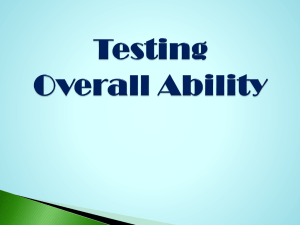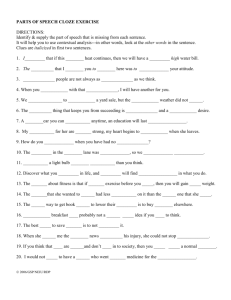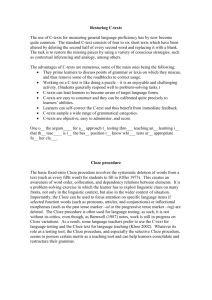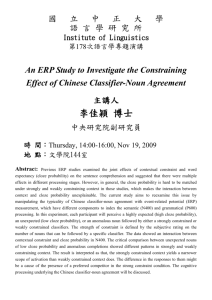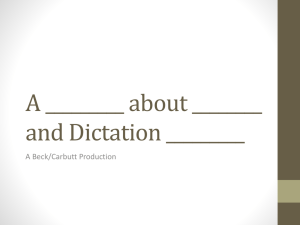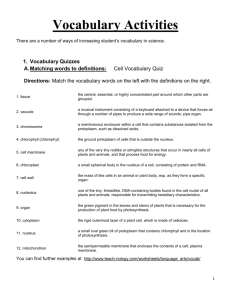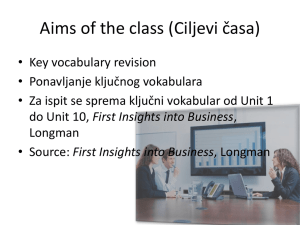Student(s) Name(s)/ ARCOTS Code: Level D
advertisement
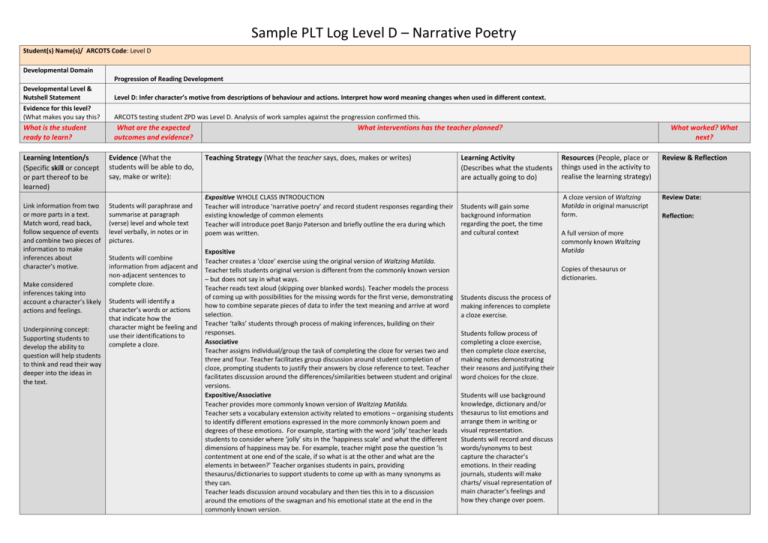
Sample PLT Log Level D – Narrative Poetry Student(s) Name(s)/ ARCOTS Code: Level D Developmental Domain Progression of Reading Development Developmental Level & Nutshell Statement Level D: Infer character’s motive from descriptions of behaviour and actions. Interpret how word meaning changes when used in different context. Evidence for this level? (What makes you say this? ARCOTS testing student ZPD was Level D. Analysis of work samples against the progression confirmed this. What is the student ready to learn? What are the expected outcomes and evidence? Learning Intention/s (Specific skill or concept or part thereof to be learned) Evidence (What the students will be able to do, say, make or write): Link information from two or more parts in a text. Match word, read back, follow sequence of events and combine two pieces of information to make inferences about character’s motive. Students will paraphrase and summarise at paragraph (verse) level and whole text level verbally, in notes or in pictures. Make considered inferences taking into account a character’s likely actions and feelings. Underpinning concept: Supporting students to develop the ability to question will help students to think and read their way deeper into the ideas in the text. Students will combine information from adjacent and non-adjacent sentences to complete cloze. Students will identify a character’s words or actions that indicate how the character might be feeling and use their identifications to complete a cloze. What interventions has the teacher planned? Teaching Strategy (What the teacher says, does, makes or writes) Expositive WHOLE CLASS INTRODUCTION Teacher will introduce ‘narrative poetry’ and record student responses regarding their existing knowledge of common elements Teacher will introduce poet Banjo Paterson and briefly outline the era during which poem was written. Expositive Teacher creates a ‘cloze’ exercise using the original version of Waltzing Matilda. Teacher tells students original version is different from the commonly known version – but does not say in what ways. Teacher reads text aloud (skipping over blanked words). Teacher models the process of coming up with possibilities for the missing words for the first verse, demonstrating how to combine separate pieces of data to infer the text meaning and arrive at word selection. Teacher ‘talks’ students through process of making inferences, building on their responses. Associative Teacher assigns individual/group the task of completing the cloze for verses two and three and four. Teacher facilitates group discussion around student completion of cloze, prompting students to justify their answers by close reference to text. Teacher facilitates discussion around the differences/similarities between student and original versions. Expositive/Associative Teacher provides more commonly known version of Waltzing Matilda. Teacher sets a vocabulary extension activity related to emotions – organising students to identify different emotions expressed in the more commonly known poem and degrees of these emotions. For example, starting with the word ‘jolly’ teacher leads students to consider where ‘jolly’ sits in the ‘happiness scale’ and what the different dimensions of happiness may be. For example, teacher might pose the question ‘Is contentment at one end of the scale, if so what is at the other and what are the elements in between?’ Teacher organises students in pairs, providing thesaurus/dictionaries to support students to come up with as many synonyms as they can. Teacher leads discussion around vocabulary and then ties this in to a discussion around the emotions of the swagman and his emotional state at the end in the commonly known version. Learning Activity (Describes what the students are actually going to do) Students will gain some background information regarding the poet, the time and cultural context What worked? What next? Resources (People, place or things used in the activity to realise the learning strategy) Review & Reflection A cloze version of Waltzing Matilda in original manuscript form. Review Date: A full version of more commonly known Waltzing Matilda Copies of thesaurus or dictionaries. Students discuss the process of making inferences to complete a cloze exercise. Students follow process of completing a cloze exercise, then complete cloze exercise, making notes demonstrating their reasons and justifying their word choices for the cloze. Students will use background knowledge, dictionary and/or thesaurus to list emotions and arrange them in writing or visual representation. Students will record and discuss words/synonyms to best capture the character’s emotions. In their reading journals, students will make charts/ visual representation of main character’s feelings and how they change over poem. Reflection: Sample PLT Log Level D – Narrative Poetry
